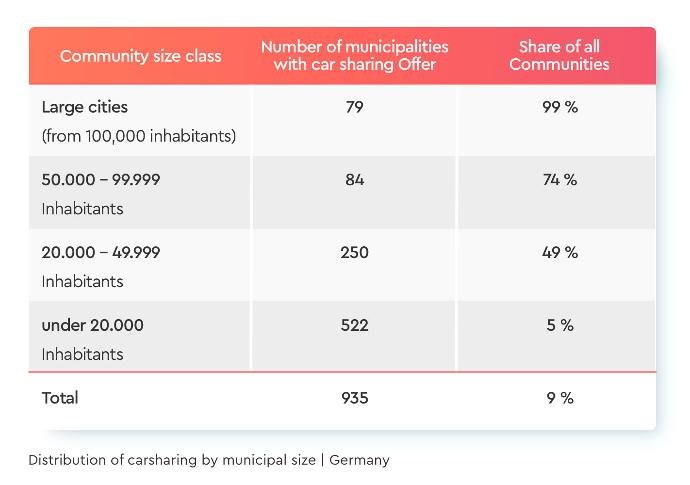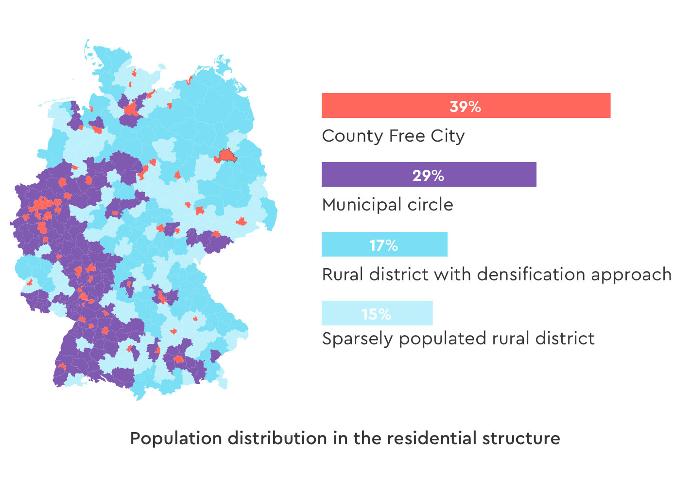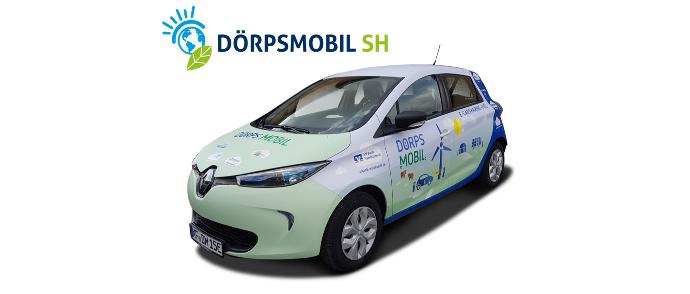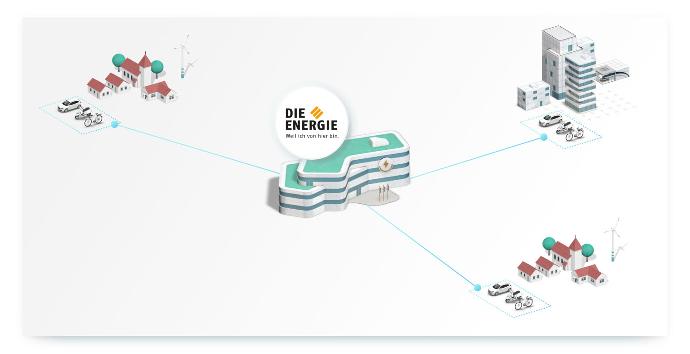If you look at the geographic distribution of shared mobility services, you quickly get the impression that they are more suitable for metropolitan areas and less so for rural areas. But is that true? One thing is clear: Mobility in the countryside works differently than in the city. But with the right approaches, carsharing & Co. can work everywhere.
How Shared Mobility Offers are Distributed
Most shared mobility services in Germany are currently limited to urban areas. Towards rural areas, the offer is still significantly smaller. Expressed in figures: While carsharing providers are present in 99% of all large cities in Germany with more than 100,000 inhabitants, the figure is only 49% in cities with 20,000 to 50,000 inhabitants, and only 5% in towns with fewer than 20,000 inhabitants.
In principle, it may be more difficult to establish a sharing service and make it profitable in small municipalities. This is due to the fact that public transport in rural regions is often less well developed, which means that more people are dependent on their own vehicles. In addition, the lower density of buildings and inhabitants means that parking pressure is less of a problem, which means that some of the driving arguments for carsharing no longer apply.

Positive development - also in rural areas
But: The numbers are also increasing in rural areas. The conditions there are different and mean that not necessarily the first car is replaced with car sharing, but possibly the second or third car. This is because the general change of mindset, away from owning and toward sharing, is also reaching more and more residents of rural regions, despite different starting situations.
 What does "rural area" mean?
What does "rural area" mean?
There is no fixed definition of what constitutes a rural area. Basically, it can be described as the opposite of an urban area: everything that is neither a metropolitan area nor the outskirts of one.

What Makes Offers in the Countryside Work
On the one hand, it is imaginable that offerings that are already established in urban areas will spread out geographically. This reduces the risk for providers, as they can draw on existing brand awareness, a fixed customer base and accumulated experience.
On the other hand, many rural services are organized as associations and rely on the voluntary commitment of the residents. This not only saves administrative and personnel costs, but also creates a sense of belonging that has a positive effect on usage.
In addition, there are rural municipalities that fund shared mobility services. After all, these also have a political interest in expanding local mobility in a more environmentally friendly way and perhaps even taking on a pioneering role in the region. Subsidies can include, for example, the tendering of public parking spaces. For providers, the financial risk decreases with each subsidy.
Another possible success factor for rural offerings is to work with so-called anchor tenants. These include, for example, municipal companies, organizations, associations or the local government. These usually have a regular need for mobility. Providers can offer them special rates or make a contingent available and thus benefit from assured capacity utilization and, in turn, secure revenues. But not only that: When representatives of the city or well-known organizations are on the road with the vehicles, this also has an effect on the outside. It increases both awareness and trust in a service.
How sharing can work in rural areas with MOQO
Start your rural sharing project with as few as 5 vehicles and benefit from:
only a few weeks until launch due to a quick setup
step-by-step tutorials in the set-up guide and MOQO Academy
support from MOQO Customer Support
access to the MOQO partner network
Station-based instead of free-floating

Like any shared mobility provider, prospective rural providers must ask themselves whether they want to offer their vehicles station-based or free-floating.
What does station-based mean?
Station-based means that a vehicle is picked up at a fixed station. The vehicle is also returned to a fixed station - either to the pick-up station (round-trip sharing) or to another station of the provider (one-way sharing). With a free-floating service, on the other hand, users can drop off the vehicle anywhere in the defined business area, which means that the pick-up locations also vary constantly.

The Dörpsmobil in Schleswig-Holstein
One example that shows how shared mobility can work successfully outside major cities is the “Dörpsmobil” in Schleswig-Holstein.
"Dörp" means "village" in Low German - and Dörpsmobils are cars that a village community uses together. The operators of a Dörpsmobil are predominantly organized as an association. Alternatively, municipalities, private individuals or companies can also be responsible. The participating villages in the initiative are in close exchange with each other and constantly learn from each other's successes, mistakes and best practices.
An important factor for the Dörpsmobil is indeed the active commitment of residents, but also of the local government. Not only those who would like to use the shared car as an alternative to a second car or as a supplement to public buses participate, but also those who offer themselves as drivers for people without a driver's license or who simply want to support the idea.
The project helps ensure that flexible mobility in rural Schleswig-Holstein is not reserved for those who own their own car. Lively participation in the villages makes younger people mobile earlier and older people mobile longer, it offers a meaningful leisure activity and helps the region to jointly master the challenges of mobility in the countryside.

Carsharing for Lohr, Karlstadt and Veitshöchheim
The Lower Franconian cities of Lohr and Karlstadt as well as the municipality of Veitshöchheim have also decided to offer their citizens a station-based car-sharing service. This is being implemented by the regional energy supplier. There are currently three stations where the cars can be borrowed: one each in Lohr (just under 16.000 inhabitants), Karlstadt (just under 15.000 inhabitants) and Veitshöchheim (just under 10.000 inhabitants).
During the day, the vehicles are used exclusively as company cars for employees of municipalities, communities and companies. This optimizes utilization and thus the financial security of the service. Outside the business hours of these anchor customers, the vehicles are available to the public.
They use it for a variety of reasons: For family outings at the weekend, (bulk) shopping, joint trips with friends, testing electric cars to use less gasoline and diesel, or even to get rid of their own car and switch permanently to the sharing service. To help users plan trips and important journeys, reservations can be made up to 90 days in advance.
What gives the offering another advantage in terms of cost-effectiveness is the pooling of forces - just as the region's energy supplier already does with regard to its core business. By not having each municipality run its own offering, the costs of parking, charging infrastructure, signage, e-car, booking software and customer service can be shared among them. For the public use of the citizens, this results in an attractive price and the great advantage that all cars can be used at all locations with one registration.
The operator also recommends networking to others who want to set up a sharing service in rural areas. This can be done by contacting other providers in the countryside in order to learn from and with each other. Or by joining a carsharing association such as the Bundesverband CarSharing e. V., which offers support, for example, in the form of advice, exchange of experience and discounts on fuel cards or vehicle insurance.

Conclusion: Yes, It Works
To implement a shared mobility project in a rural region, it is important that you understand the special features, weak points and gaps in local mobility and then start right there. After all, only an offer that is specifically tailored to the needs of the target group can endure - regardless of whether it is in the city or in the countryside.
The general rethinking in society as well as the economic development lead also in rural areas to more and more people asking themselves how many cars a family of four really needs. But no one wants to be there an hour and a half before their dentist appointment because the bus only runs every two hours. That's why shared mobility offers are an important piece of the puzzle when it comes to sustainable, environmentally friendly and flexible mobility.
Find allies and partners, address your target group's pain points, and find the right ways to address and reach them. Shared mobility works differently in rural areas than in cities - but it works.





